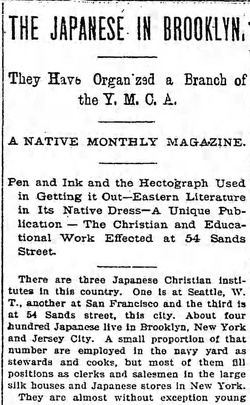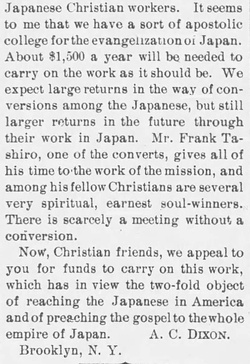One aspect of Japanese American history that I have been fascinated to uncover is that of family dynasties—the sagas of clans with multiple members who made outstanding commercial, scientific or artistic contributions. One such clan is the Tajiris, a family whose members included the journalists Larry Tajiri and his wife Guyo; the sculptor Shinkichi Tajiri; the photographer Vince Tajiri; and the writer/newspaperwoman Yoshiko Tajiri Roberts, as well as their multiple generations of creative descendants (such as the artists Giotta and Ryu Tajiri, the filmmaker Rea Tajiri, the scholar Vince Schleitwiler, and the writer Chiori Santiago, among others).
Another extraordinary clan is the Oyama family, who in one generation produced the writers and artists Mary Oyama Mittwer, Joe Oyama, and Lillie Oyama Sasaki, as well as the businessmen and inventors Wesley Oyama and Clem Oyama—many of whom themselves had creative spouses and children. Or the Takamine family, which boasted three generations of scientists and physicians. There is also the Asai family of Ithaca, New York, all of whose nine children attended Cornell University. I recall the wondrous Uno clan of California and Utah, or the Ohnick/Onuki clan of Arizona and Seattle.
I recently came upon the story of the Tashiro clan of Cincinnati, New England, and Seattle, whose members maintained close connections over time. Though oddly unheard of today, the Tashiros rank high in the category of diverse and accomplished Japanese American families, as its members distinguished themselves in both science and the arts. (It should be noted that, there are several other notable Tashiros to whom this Tashiro clan is not connected, as far as I am aware: Dr. Kukuwo [Kikuo] Tashiro, the founder of the Japanese hospital in Los Angeles; the Hawaii lawyer Benjamin Tashiro; the notable Hawaiian-born dentist and activist from Chicago, Dr. Isamu Tashiro; the Cornell University entomologist Dr. Haruo Tashiro; the World War II draft resister Frank Kiyoshi Tashiro; and the MIS Veteran and career CIA officer Jack Tashiro).
The main founders of the Tashiro clan I am studying were two Issei brothers, Aijiro and Shirosuke Tashiro. They were born in Japan in the late 19th century, the sons of Shirobe and A. Tashiro, and grew up in Kamitogo, Kagoshima-Ken.
In my first installment, I will speak about the elder brother, Aijiro (sometimes known in the United States as “Frank”).
* * * * *
Aijiro, who was born in 1866, left Japan in the early 1890s. According to family legend, the reason for his departure was that he was not the chonan (eldest son) and so could not expect to inherit the family lands. Conversely, like many Issei men, he chose to emigrate to America to evade conscription into the Japanese Army.
He first went to China as an interpreter, claiming a little knowledge of spoken and written Chinese, and lived for a time in Shanghai. There he found a job as a cabin boy on a military ship sailing to the West. Tashiro’s ship stopped for a time in Liverpool, Great Britain, where he became acquainted with the members of the local Young Men’s Christian Association (YMCA).
Tashiro’s ship arrived in New York City in 1892. According to one later account, he learned to read English while on a ship in the Brooklyn Navy Yard. According to another account, he jumped ship in New York and took a letter of introduction from his Liverpool friends to the New York YMCA on East 27th street, where he was welcomed by its members.
Whatever the case, he clearly determined to stay in the country, as in 1893 he petitioned for U.S. citizenship—it was unclear at that point whether Japanese were eligible on racial grounds. In any case, his request was ultimately rejected.
The young Tashiro soon moved to Brooklyn, then a separate city. Brooklyn’s small Japanese community was concentrated around the Brooklyn Navy Yard and the school of Tel (Teru) Sono, whose groundbreaking spiritual autobiography The Japanese Reformer was published in 1892.
Frank became an active Christian, working with his fellow immigrants. In February 1894, he was baptized, along with five other Japanese converts, he was baptized by Reverend A.C. Dixon at the Hanson Place Baptist Church.
A newspaper article in February 1895 announced that Frank Tashiro would be presenting a lecture at the Brooklyn YMCA on Fulton Street, in collaboration with his colleague J.H. Tsasumi (sic). The lecture, on customs of the Japanese people, was described as being accompanied by images from a stereotypicon (moving lantern). In March 1895, Frank took part in a vocal music program at the YMCA.
In the following months, Tashiro became active with a fledgling Japanese Christian institute on Sands St. that had been organized by the Hanson Place Baptist Church. In December 1895, he was listed as the mission’s manager, who was responsible for leading Sunday evening services, and as superintendent of the YMCA chapter there.
Rev. Dixon, in a letter to the journal Baptist and Reflector, asserted, “Mr. Frank Tashiro, one of the converts, gives all his time to the work of the mission, and among his fellow Christians are several very spiritual earnest soul-winners.”
Tashiro, for his part, did not see his work as simply that of conversion. Rather, as he explained to a reporter for the Brooklyn Eagle, his goal was to aid young Japanese immigrants.
We have already regularly organized prayer meetings and gatherings for social purposes, together with a literary society and a night school for the study of the English language principally…
We have already commenced to get a library together and I hope we shall soon have such a collection of books as will be of service to our young men, whether they decide to remain in America or return home after they have acquired an education.
He showed the reporter a copy of a new Japanese YMCA magazine published by the institute, to which he had contributed an article on the goals of the Institute, entitled “A Story of Three Companions and Lord’s Tenderly Calling.” He seems to have kept active with the Institute in the period that followed.
Two years later, at a fourth anniversary event for the Institute held at the Hanson Street Baptist Church, he made a brief speech about its work.
During the following years, there is little information about Tashiro on the record. According to one source, Frank worked at the Brooklyn Navy Yard. He seems to gave given up his evangelical work, though he remained a committed Christian.
In any case he seems to have moved to Chicago not long after, as the 1900 census lists Aijio Tashiro as a live-in butler for the family of Morris Edwards on Michigan Avenue in Chicago. While the reasons for the move West are not clear, it was likely connected with the arrival of Aijiro’s two (much) younger brothers, Toyogi and Shirosuke, who immigrated to the United States in 1901.
While in Chicago, Aijiro met Onaozan “Nao” Hasegawa, whom he married in May 1904. Nao was a young educated woman from Northern Honshu. It was unusual for such a Northerner to marry a man from the southernmost tip of Kyushu, but the two spouses were likely brought together by their common commitment as Christians.
The new couple soon embarked on road tours, peddling Japanese goods. In July 1905, a local newspaper in Benton Harbor, Michigan noted that Mr. and Mrs. A. Tashiro were coming to town to sell their goods, and recommended their quality. Shortly after, Aijiro Tashiro was reported to be coming to sell his goods in Atlantic City, New Jersey. (The newspaper wrote that locals had hoped that he might be a Japanese government envoy sent to restart the stalled peace talks over the Russo-Japanese War!)
By 1906, the couple had moved to Waterbury, Connecticut. According to one grandson, Ken A. Tashiro, “They had a small boardwalk business called Japanese Ping Pong which did all right in the summer months but closed down for the winter season.”
During the next years, they had five children: Kenji, Aiji, Saburo [AKA Sabro], Aiko, and Arthur. Over the following winters, Frank and Nao attempted different money-making plans. In 1907, the family moved to Pawtucket, Rhode Island, where “K. Tashiro” operated a Japanese art curio store. (During his time in Rhode Island, Tashiro was also credited as a member of the Esperanto Society, founded to develop and disseminate the universal language of Esperanto).
By 1909, Aijiro Tashiro was listed as the manager of a Japanese store and tea house on Chapel St. in New Haven. He remained in New Haven for approximately ten years, even as his brother Toyogi moved to the area. City directories for the period 1912 to 1919 list one “Aisio Tashiro” as the manager of a restaurant on Church St., and Toyogi Tashiro as his employee. The restaurant was ultimately called Tashiro Brothers, with Aijiro and Toyoji as co-owners.
Shortly before September 1919, when their youngest child Arthur was born, the Tashiro family moved to Seattle, Washington. Aijiro worked as a merchant. Ultimately, Aijiro and Nao ran a Japanese Women’s Home on Spruce Street. Arthur later recalled that his father would take him to visit U. S. Navy ships when they came to Seattle, in order to meet what seemed to be “old naval buddies.”
In 1928 the Tashiro family moved to Los Angeles, California, where their oldest son Ken had already settled. Nao contracted spinal meningitis that August and died on September 16, 1929. The family was devastated by her death and by the ravages of the Great Depression. The youngest child, Arthur, was sent to live with his uncle in Cincinnati. Aijiro moved into a boarding house and found work as a domestic laborer for a local Christian family. He died in Los Angeles on April 10, 1939.
© 2023 Greg Robinson









